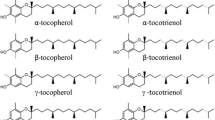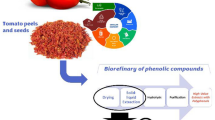Abstract
Industrial tomato processing by-products are intended mainly for animal feed or fertilizer, though they can be used for the recovery of valuable constituents. Carotenoids constitute an important component of these by-products, well credited with important health-promoting functions. This study examined the effect of several organic solvents (hexane, ethanol, acetone, ethyl acetate, ethyl lactate and their mixtures), and extraction temperature on the recovery and isomerization of carotenoids from tomato processing by-products. Another area under investigation was the stability of carotenoids, as affected by drying and storage conditions of tomato by-products. HPLC–DAD analysis was applied for the efficient separation and analysis of the carotenoids and their cis-isomers. The highest extraction yield was obtained with ethyl lactate (203.6 μg/g dry by-product) followed by hexane–ethyl acetate mixture with a considerably lower yield (36.1 μg/g dry by-product). The identified carotenoids in all solvent extracts followed the order: lycopene ≫ β-carotene > lutein, in their predominant trans-configuration. Among the identified isomers, 5-cis lycopene and 15-cis-β-carotene were the most abundant in all extracts. The increase of extraction temperature increased the total lycopene concentration in all extracts, whereas cis-isomers remained lower than 8 % in most solvents. A steadily high percentage of cis-isomer (≈30 %) was observed in ethyl lactate extracts, independent of temperature. Conversely, the increase of extraction temperature induced a reduction in total β-carotene and total lutein concentration in all solvents, while cis-isomers were not detected. Drying or even cold storage of the raw material led to decreased yields, and affected lycopene isomerization with a considerable increase of cis-isomers.


Similar content being viewed by others
References
Al-Wandawi, H., Abdul-Rahman, M., Al-Shaikhly, K.: Tomato processing wastes as essential raw material sources. J. Agric. Food Chem. 33, 804–807 (1985)
Topal, U., Sasaki, M., Goto, M., Hayakawa, K.: Extraction of lycopene from tomato skins with supercritical carbon dioxide: effect of operating conditions and solubility analysis. J. Sci. Food Agric. 54, 5604–5610 (2006)
Strati, I.F., Oreopoulou, V.: Effect of extraction parameters on the carotenoid recovery from tomato waste. Int. J. Food Sci. Technol. 46, 23–29 (2011)
Shi, J., Le Maguer, M., Kakuda, Y., Liptay, A., Niekamp, F.: Lycopene degradation and isomerization in tomato dehydration. Food Res. Int. 32, 15–21 (1999)
Clinton, S.K., Emenhiser, C., Schwartz, S.J., Bostwick, D.G., Williams, A.W., Moore, B.J.: Cis–trans lycopene isomers, carotenoids, and retinal in the human prostate. Cancer Epidemiol. Biomark. Prev. 5, 823–833 (1996)
Van Breemen, R.B., Xu, X., Viana, M.A., Chen, L., Stacewicz-Sapuntzakis, M., Duncan, C., Bowen, P.E., Sharifi, R.: Liquid chromatography–mass spectrometry of cis- and all-trans lycopene in human serum and prostate tissue after dietary supplementation with tomato sauce. J. Agric. Food Chem. 50, 2214–2219 (2002)
Boileau, T.W., Boileau, A.C., Jr, Erdman J.W.: Bioavailability of all-trans and cis-isomers of lycopene. Exp. Biol. Med. 227, 914–919 (2002)
Moraru, C., Lee, T.C.: Kinetic studies of lycopene isomerization in a tributyrin model system at gastric pH. J. Agric. Food Chem. 53, 8997–9004 (2005)
Boileau, A.C., Merchen, N.R., Wasson, K., Atkinson, C.A., Erdman, J.: Cis lycopene is more bioavailable than trans-lycopene in vitro and in vivo in lymph-cannulated ferrets. J. Nutr. 129, 1176–1181 (1999)
Teodoro, A.J., Perrone, D., Martucci, R.B., Borojevic, R.: Lycopene isomerisation and storage in an in vitro model of murine hepatic stellate cells. Eur. J. Nutr. 48, 261–268 (2009)
Richelle, M., Sanchez, B., Tavazzi, I., Lambelet, P., Bortlik, K., Williamson, G.: Lycopene isomerisation takes place within enterocytes during absorption in human subjects. Br. J. Nutr. 103, 1800–1807 (2010)
Strati, I.F., Sinanoglou, V.J., Kora, L., Miniadis-Meimaroglou, S., Oreopoulou, V.: Carotenoids from foods of plant, animal and marine origin: an efficient HPLC-DAD separation method. Foods 1, 52–65 (2012)
AOAC method 925.09 (1999)
Tai, C.Y., Chen, B.H.: Analysis and stability of carotenoids in the flowers of daylily (Hemerocallis disticha) as affected by various treatments. J. Agric. Food Chem. 48, 5962–5968 (2000)
Ishida, B.K., Chapman, M.H.: Carotenoid extraction from plants using a novel, environmentally friendly solvent. J. Agric. Food Chem. 57, 1051–1059 (2009)
Periago, M.J., Rincon, F., Aguera, M.D., Ros, G.: Mixture approach for optimizing lycopene extraction from tomato and tomato products. J. Agric. Food Chem. 52, 5796–5802 (2004)
Riggi, E., Avola, G.: Fresh tomato packing houses waste as high added-value biosource. Resour. Conserv. Recycl. 53, 96–106 (2008)
Lee, M.T., Chen, B.H.: Stability of lycopene during heating and illumination in a model system. Food Chem. 78, 425–432 (2002)
Shi, J., Dai, Y., Kakuda, Y., Mittal, G., Xue, S.J.: Effect of heating and exposure to light on the stability of lycopene in tomato puree. Food Control 19, 514–520 (2008)
Wang, C.Y., Chen, B.H.: Tomato pulp as source for the production of lycopene powder containing high proportion of cis-isomers. Eur. Food Res. Technol. 222, 347–353 (2006)
Calvo, M.M., Dado, D., Santa-Marιa, G.: Influence of extraction with ethanol or ethyl acetate on the yield of lycopene, β-carotene, phytoene and phytofluene from tomato peel powder. Eur. Food Res. Technol. 224, 567–571 (2007)
Sharma, S.K., Le Maguer, M.: Kinetics of lycopene degradation in tomato pulp solids under different processing and storage conditions. Food Res. Int. 29(3–4), 309–315 (1996)
Zanoni, B., Peri, C., Nani, R., Lavelli, V.: Oxidative heat damage of tomato halves as affected by drying. Food Res. Int. 31(5), 395–401 (1998)
Daood, H.G., Kapitany, J., Biacs, P., Albrecht, K.: Drying temperature, endogenous antioxidants and capsaicinoids affect carotenoid stability in paprika (red pepper spice). J. Sci. Food Agric. 86, 2450–2457 (2006)
Lefsrud, M., Kopsell, D., Sams, C., Wills, J., Both, A.J.: Dry matter content and stability of carotenoids in kale and spinach during drying. HortScience 43(6), 1731–1736 (2008)
Anguelova, T., Warthesen, J.: Lycopene stability in tomato powders. J. Food Sci. 65, 67–70 (2000)
Nguyen, M.L., Schwartz, S.J.: Lycopene stability during food processing. Exp. Biol. Med. 218, 101–105 (1998)
Author information
Authors and Affiliations
Corresponding author
Rights and permissions
About this article
Cite this article
Strati, I.F., Oreopoulou, V. Recovery and Isomerization of Carotenoids from Tomato Processing By-products. Waste Biomass Valor 7, 843–850 (2016). https://doi.org/10.1007/s12649-016-9535-z
Received:
Accepted:
Published:
Issue Date:
DOI: https://doi.org/10.1007/s12649-016-9535-z




